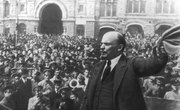When it comes to the relationship between employers and employees, there are three main theories that take precedence today. These theories of industrial relations were all formed in the past century and have not changed much in the past 50 years. Two of these theories describe the relationships in terms of conflict, while the third emphasizes cooperation.
Tip
The three main theories of industrial relations are the unitary, pluralist and Marxist perspectives.
Marxist Perspective of Industrial Relations
The Marxist view of industrial relations is of a clash between the employer (capitalist) and the worker. The employer tries to maximize profit by paying workers as little as he can while striving for a monopoly in his industry to control prices. Workers, on the other hand, believe that they are the most vital part of production and strive to get their fair share of profits through the formation of trade unions.
From a Marxist perspective, the inevitable result of this clash is a worker revolution, where workers take control of companies, eliminating the capitalist altogether. Although Marxism has fallen out of favor since the collapse of the Soviet Union, it was highly popular in the first half of the 20th century, when workers were paid subsistence-level wages. While there are no signs of Marxist revolution happening soon, the U.S. minimum wage has remained at a mere $7.25 (or $15,000 annually) for over 10 years.
The Pluralist Theory of Industrial Relations
In pluralist theory, the relationship between employers and workers is also one of conflict but not to the extent Marxism portrays it. Through trade unions, workers argue for higher wages, increased benefits and better working conditions, while employers want to keep as much money as they can for profit. Rather than violence, however, the two sides negotiate to reach a middle ground, or equilibrium.
An important part of this model is that workers recognize that it's in their best interest for the company to thrive, so while they are loyal to the union, they are also loyal to the employer. Employers, meanwhile, understand that fair wages and good working conditions make employees more productive. This delicate balancing act between interests became prominent in the 1930s during Roosevelt's New Deal government and is still a popular model at many companies today.
Unitary Theory of Industrial Relations
The unitary perspective on employee relations is one of cooperation. Employers and workers are seen as being on the same team or even the same family. They have the same interests and share the same values and goals. In this model, conflict is seen as distasteful or even evil, and both sides strive for consensus.
Those who subscribe to this theory (employers and employees alike) despise trade unions. Unions are portrayed as an outside force that competes for the employer's loyalty and pits employees against management. Many small businesses operate with this theory as well as any company where workers reject the idea of unionizing. Governments that favor this theory will place restrictions on unions or even make them illegal.
Industrial Relations in Practice
Industrial relations is the study of one portion of a society. It is an abstraction that can't take into account all of the factors that affect human behavior or the complexities of society as a whole. Consequently, theories on industrial relations can only highlight some important aspects of employer-worker relationships and do not provide a full picture of those relationships.
However, understanding these theories and the aspects of the relationships on which they focus can give employers and workers important insights about their own workplaces. If a business owner approaches workers in a spirit of cooperation, she will likely find that the employees she chooses to hire will respond in a similar way. On the other hand, if the business owner views workers as people whose wages reduce profits, it shouldn't be surprising if workers respond with conflict or animosity.
Related Articles
References
Writer Bio
A published author and professional speaker, David Weedmark has advised businesses and governments on technology, media and marketing for more than 20 years. He has taught computer science at Algonquin College, has started three successful businesses, and has written hundreds of articles for newspapers and magazines throughout Canada and the United States.










